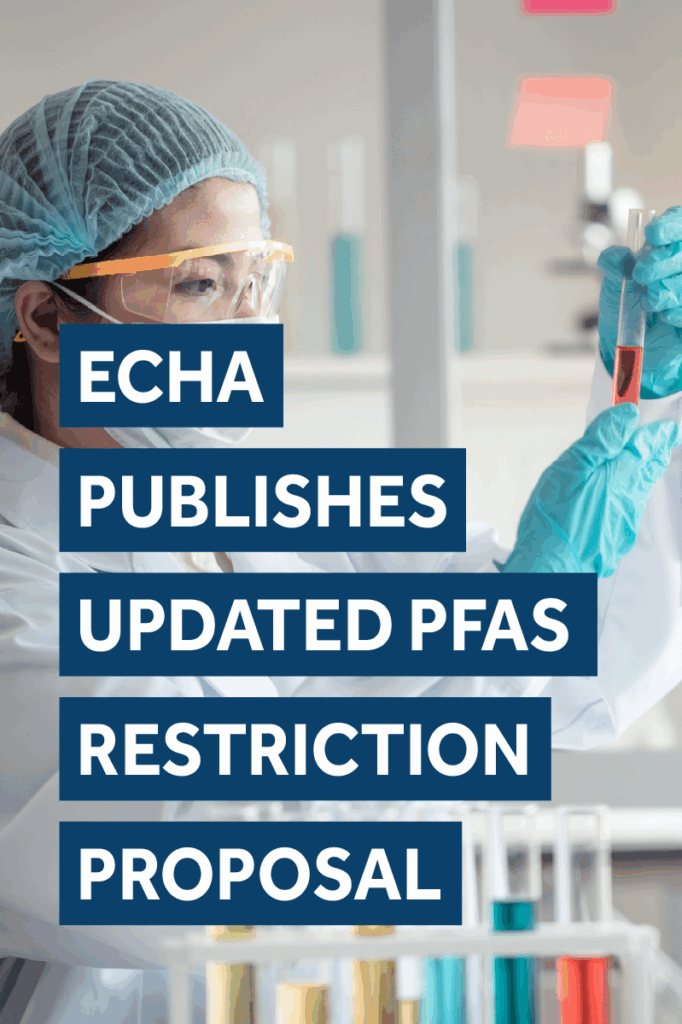PFAS | EU REACH
September 5, 2025 | Written by GreenSoft Technology, Inc.
EU PFAS Ban Update:
ECHA Takes Next Step in Restricting PFAS under EU REACH

ECHA publishes updated PFAS restriction proposal
On August 20, 2025, the European Chemicals Agency (ECHA) published an updated proposal to restrict per- and polyfluoroalkyl substances (PFAS) under the EU REACH regulation.
After evaluating comments received from third parties during the consultation period, the authorities from Denmark, Germany, the Netherlands, Norway, and Sweden have updated their 2023 PFAS restriction proposal. The revised report, known as the Background Document, now serves as the basis for ECHA’s committee opinions.
This is another step in an ongoing, multi-stage effort to define and restrict PFAS in the EU that has been evolving for years.
Background on the PFAS Restriction Process
In July 2020, five national authorities, Denmark, Germany, the Netherlands, Norway, and Sweden formed a coalition on the restriction proposal for all PFAS. In January 2023, they formally submitted the restriction dossier to the European Chemicals Agency (ECHA), and in February 2023, ECHA published the proposal, triggering the standard EU REACH restriction process.
Within ECHA, the Risk Assessment Committee (RAC) and the Socio-Economic Analysis Committee (SEAC) are continuing their review of the proposed PFAS restriction. Their evaluation is being carried out sector by sector, examining the impacts on each industry individually.
PFAS Restriction Options Being Considered
- Restriction Option 1 (RO1) would impose a full ban on PFAS, with only a few derogations for essential uses where no alternatives are available. It includes a short transition period of about 18 months after entry into force. However, RO1 is considered unrealistic and difficult to implement in practice.
- Restriction Option 2 (RO2) would be implemented through EU REACH Annex XVII. It would allow wider exemptions through time-limited transition periods of 5 or 12 years, or in some cases without a fixed limit, depending on the sector, product, and/or application. These derogations could later be reviewed and withdrawn once suitable alternatives are available. See the proposed examples below for the EEE sector.
- Coatings and films on displays and lenses of electronic complex objects for 6.5 years after Entry into Force (EiF).
- Printed circuit boards and antennas for 13.5 years after EiF
- Photonics for 13.5 years after EiF
- Semiconductor manufacturing until 13.5 years after EiF
- Coatings and films of electronic components (excluding displays and lenses) for 13.5 years after EiF
- Binders and electrolytes in batteries until 13.5 years after EIF
- Restriction Option 3 (RO3) represents a sector-specific, balanced approach. It's seen as both practical and enforceable, with the added advantage of delivering significant emissions reductions.
Planned Upcoming Committee Meetings
Several upcoming committee meetings will play a key role in shaping the final restriction:
- Electronics and Semiconductors Sector
- RAC Committee: Discussion to be continued in September 2025 meeting
- SEAC Committee: Discussion tentatively scheduled for September and December 2025 meetings
- Lubricants Sector
- RAC Committee: Discussion to be continued in September 2025 meeting
- SEAC Committee: Discussion to be continued in September 2025 meeting
What This Means for Electronics Manufacturers
Electronics manufacturers should pay close attention to these developments. PFAS are widely used in semiconductors, printed circuit boards, coatings, films, and batteries—all of which are directly addressed in the proposed restriction timelines. Even under the more flexible restriction options, exemptions are time-limited, and regulators may shorten or withdraw them as alternatives become available.
Companies that use PFAS in their products must begin planning for substitution strategies, supplier engagement, and compliance reporting to avoid disruptions as the restriction moves closer to adoption.
GreenSoft’s Proactive PFAS Solution
GreenSoft helps electronics manufacturers stay ahead of regulatory changes with our Proactive PFAS Solution. Our supply chain data collection services and compliance software provide full visibility into PFAS use across your supply chain so you can assess risks, identify alternatives, and maintain compliance with evolving global regulations.
Don’t wait until the EU PFAS restriction becomes law—partner with GreenSoft today to protect your business and stay compliant. Contact us to learn more or schedule a personalized demo.

